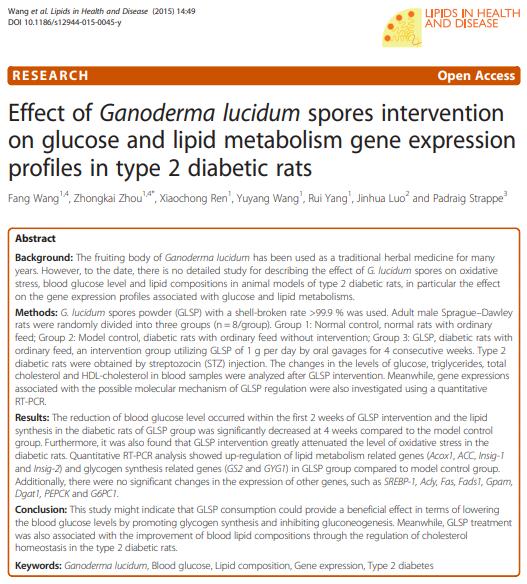Может 22, 2015 / Tianjin University of Science and Technology / Lipids in Health and Disease

Текст/У Тинъяо
There have been many scientific discussions on howГанодерма яркая fruiting bodies can improve diabetes, but there are few related studies on the role ofГанодерма яркая spores in this regard. This report, published in “Lipids in Health and Disease” by Tianjin University of Science and Technology, China, explores the effect of shell-brokenГанодерма яркая споровый порошок(GLSP) with a shell-broken rate >99.9% on blood glucose, blood lipids and oxidative stress in type 2 диабетические крысы.
The three groups of male rats participating in the experiment are all adults, с 8 rats in each group. Группа 1: Normal control, normal rats with ordinary feed; Группа 2: Model control, diabetic rats with ordinary feed without intervention; Группа 3: GLSP, diabetic rats with ordinary feed, an intervention group utilizing GLSP of 1 g per day by oral gavages for 4 consecutive weeks. In rats, тип 2 diabetes results from the destruction of islet cells by injection of Streptozocin.
It was found that the blood glucose of diabetic rats that ate shell-brokenГанодерма яркая spore powder began to drop from the second week and was 21% lower than that of diabetic rats that did not take Ganoderma lucidum by the end of the fourth week, but it was still four times the blood glucose of normal rats.
In terms of blood lipid compositions, compared with diabetic rats that did not eat the shell-brokenГанодерма яркая споровый порошок, the total cholesterol of diabetic rats in theГанодерма яркая group was reduced by 49%, and their triglycerides were reduced by 17.8%. Однако, these indexes of both of them were far away from those of normal rats (their total cholesterol is about five times that of normal rats, and their triglycerides are one and a half times as much.) Only HDL-C, commonly known as “good cholesterol,” rises to levels close to that of normal rats.
Diabetes can significantly increase the oxidative stress in the body, but eating shell-brokenГанодерма яркая spores for four weeks can significantly reduce the concentration of MDA (Малондиалдегид) and ROS (reactive oxygen species) in the blood of diabetic rats. These two values are still higher than those of normal rats, but the two important antioxidant enzymes, GSH-Px (glutathione peroxidase) and SOD (супероксиддисмутаза) are also higher than those of normal rats, showing that shell-brokenГанодерма яркая spores can effectively enhance the antioxidant capacity of diabetic rats, thereby alleviating excessive oxidative stress.
Further analysis revealed that several genes related to lipid metabolism (Acox1, ACC, Insig-1 and Insig-2), as well as genes related to glycogen synthesis (GS2 and GYG1), have more expression levels than those diabetic rats who did not eat shell-brokenГанодерма яркая споры. Однако, some genes showed no significant differences, including SREBP-1, Acly, Fas, Fads1, Gpam and Dgat1 involved in lipid metabolism, and PEPCK and G6PC1 involved in carbohydrate metabolism.
All in all, although there is still some distance from “returning to normal”, the shell-brokenГанодерма яркая spore powder has shown its benefits for type 2 diabetes within a month, including lowering blood glucose and blood lipids. From the perspective of gene expression, its mechanism of action may be related to promoting glycogen synthesis, inhibiting gluconeogenesis (ингибирование превращения неуглеводов в глюкозу), и регулирование доли ЛПВП в холестерине. Что касается того, какие активные ингредиенты разрушают скорлупуГанодерма яркая споровый порошок эффективен, в этой статье конкретно не уточняется..
[Источник] Ван Ф, и др.. Эффект Ганодерма яркая Вмешательство спор на профили экспрессии генов метаболизма глюкозы и липидов у типа 2 диабетические крысы. Липиды Здоровье Дис. 2015 Может 22;14:49. дои: 10.1186/s12944-015-0045-у.
КОНЕЦ
Об авторе/ г-жа. У Тинъяо
У Тинъяо сообщает информацию из первых рук о Ганодерма с тех пор. 1999. Она является авторомЛечение с помощью Ганодерма (опубликовано в Народном медицинском издательстве в апреле 2017).
★ Статья публикуется с исключительного разрешения автора..
★ Воспроизведение вышеуказанных работ не допускается., извлечены или использованы иным образом без разрешения автора.
★ За нарушение вышеуказанного заявления, автор будет нести соответствующую юридическую ответственность.
★ Оригинальный текст этой статьи был написан на китайском языке У Тинъяо и переведен на английский Альфредом Лю.. Если есть расхождения в переводе (Английский) и оригинал (китайский), оригинальный китайский будет иметь преимущественную силу. Если у читателей возникнут вопросы, пожалуйста, свяжитесь с первоначальным автором, РС. У Тинъяо.



